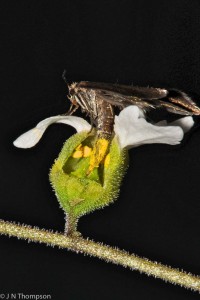The Laboratory of Coevolutionary Biology
The earth has millions of species. 
Coevolution organizes these species into complex webs:
predators and prey, hosts and parasites, competitors, and mutualists.
The result is what Darwin called the Entangled Bank.
Others call it the Web of Life.
Research goal:
How and why has the web of life become so entangled?
1.How does natural selection differ among different forms of interaction (e.g., parasitism, grazing, predation, competition, mutualism)?
2. How and why do species specialize in their interactions with other species, and how do different forms of specialization shape the process of coevolution?
3. How does local adaptation shape interactions among species and the coevolutionary process within webs of interacting species?
4. Why is evolution so relentless, and how do interactions among species contribute to the relentlessness?
Our growing understanding of the answers to these questions is explored in these four books and in the articles found on the Publications page.
1. Interaction and Coevolution (1982; reissued 2014):
Why does natural selection act differently on different forms of interaction among species?
Can we develop general principles about the coevolutionary process?
2. The Coevolutionary Process (1994):
Why does natural selection favor some species that specialize by interacting with only a few species and other species that interact with many species?
Why do interactions among species evolve, and sometimes coevolve, in different ways in different environments?
How does the history of evolutionary ecology and coevolutionary biology help us understand our current hypotheses and predictions?
3. The Geographic Mosaic of Coevolution (2005):
How does coevolution shape local adaptation and coadaptation interactions among species across ecosystems, regions, and continents?
Why does the geographic mosaic of coevolution differ among different forms of interaction -- e.g., mutualistic interactions, competitors, parasites and hosts?
How does coevolution shape webs of interacting species?
4. Relentless Evolution (2013):
Why do species evolve relentlessly, even when they seem fairly well adapted to their environments?
How to interactions among species contribute to the relentlessness of evolution?
Over short time scales, how do species, and interactions among species, evolve in nature?
How do the apparent patterns of relentless evolution differ over short and long time scales?





